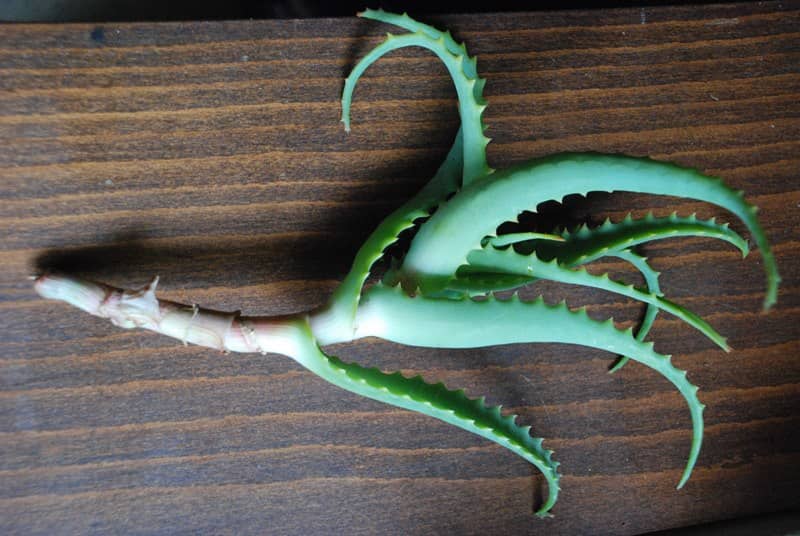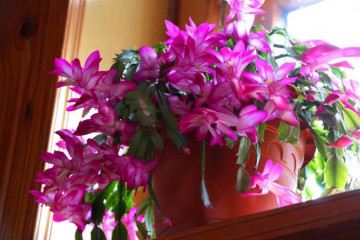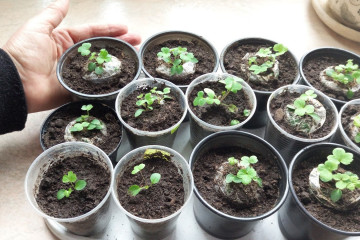How to propagate aloe: examples by cuttings and other methods
Content:
Aloe is a plant that from generation to generation is revered in many families as a family doctor. It has been known since ancient times, described in the works of many founders of medicine - Hippocrates, Paracelsus, Avicenna. The true goddess of beauty, Queen Cleopatra, also mentioned him. Its juice helps with many diseases: it protects against the common cold, helps to cope with stomach ailments and skin problems. Women of all ages make masks from it for face, neck, hair. Many people want to get such a flower, ask for it from neighbors, friends, relatives. Therefore, the question of how to propagate aloe at home does not lose its relevance.
Types of aloe for reproduction
There is no universal solution to how to propagate aloe of one kind or another. The methods are the same for all varieties. Florists who are engaged in the cultivation of these plants use the methods that are most convenient for individual species. Everyone chooses for himself how to breed aloe in his home.
Vera
Aloe vera is the most popular home grown species. Its distinctive features are a short stem and long fleshy leaves, collected in rosettes. The leaves are light green, covered with whitish spots, and have sharp thorns along the edges. They practically do not bloom, so seed reproduction is practically impossible for aloe vera. Most often, the reproduction of aloe of this species occurs in the apical way or with the help of shoots.
Aloe tree
He is more often called an agave, because his life expectancy is simply amazing. Its main characteristic is long, pointed, elongated leaves attached to the stem. Thanks to them, it becomes clear how to breed aloe tree-like - by rooting the leaf.
Aloe variegated (brindle)
It is characterized by a variegated color of long (up to 30 cm) leaves, due to which the flower got its name. The most convenient breeding methods: by tops or seedlings by children.
Aloe fan
Outwardly, it is a shrub with a gradually lignified stem. Leaves are rounded, long (up to 30 cm) and wide (up to 5 cm). A distinctive feature of this species is how the aloe fan reproduces. It is characterized by seed reproduction, which is rare for succulents. It blooms quite often, with proper care it does it annually. Scarlet flowers are located on long thin stems.
Breeding options for aloe at home
Since the process of flower reproduction itself can take several days, you need to carefully prepare for it. This will require the following materials:
- a new pot for planting a young plant. If reproduction will take place with the help of children, then containers with water in which they will be stored will also come in handy;
- priming. A universal composition purchased in a store or for succulents is best suited;
- a spatula to dig up the sprouts and transplant them into a new container;
- a sanitized sharp knife, which is required to cut off leaves or shoots;
- root growth stimulants that will help speed up the long rooting process of the plant.
Cuttings
To reproduce aloe using cuttings, you need to follow the following instructions:
- Carefully cut the stalk with a sharp, disinfected knife. A utility knife or garden shears will work well.
- You only need to cut a healthy, undamaged shoot carefully at its very base. For 5-7 days, the stalk should be placed in a place where the sun's rays will not fall, and where the air humidity will be at least 50% (for example, in a cabinet) until a transparent film forms at the cut site.
- Drainage holes must be made in the prepared pot, a drainage layer is required at the bottom.
- After the cut dries up, it should be treated with wood ash and deepened into the prepared soil to a depth of 4-5 cm. The soil should be slightly damp.
- It is better if the leaves do not touch the topsoil, as otherwise they may rot.
Seeds
The seed method of reproduction is the rarest at home, it is more often chosen by mass producers. Therefore, for this method, it is better to buy ready-made material in the store. But, if you managed to independently collect seeds from flowering succulents, this is also great. In both cases, for seed germination, you must follow the step-by-step instructions:
- The seeds are planted in prepared soil. It is better if it is a ready-made soil for succulents, since the seeds will take root in it faster. They are deepened 3 cm into the soil, keeping a distance of 1.5 cm between them.
- The soil is moistened with settled water and covered with a film, which must be lifted daily for ventilation.
- The container with seeds must be kept in a warm place (with a temperature of at least 22 ° C) and watered with a spray bottle as the topsoil dries out.
- When shoots appear, the film is removed. Next, you need to wait for the first 2-3 leaves and transplant the plants into separate pots.
The top
There is another option for rooting aloe - using the tip. This method can injure an adult plant, but thanks to it, young shoots quickly adapt to new conditions, due to which rapid growth will follow. The landing sequence is as follows:
- The top is carefully cut so that at least 8 leaves remain on it.
- The resulting shoot must be placed in water, to which a phytohormone has been added, designed specifically for root germination. In this container, you must hold the cut top for 40 minutes.
- Place the cut in water at room temperature and put it in a warm place for a long time until the new plant has roots. This can take several weeks. Water periodically needs to be topped up, in some cases changed.
- Transplanting into a pot of soil is carried out only when the roots reach 6 cm in length.
Children
Reproduction by children is not typical for all varieties of aloe.Accordingly, it is suitable only for those who have these same children. If it is important that new seedlings appear in this way, then it is advisable to choose a cramped pot for an adult plant, so that all its power goes not to its own development, but to the formation of a young growth. If they appear, then they are immediately planted in separate pots, observing the following instructions:
- Completely remove the entire plant from the vessel in which it grew, and put it on paper / napkins / newspaper. In this case, the soil should be moderately moist.
- The cut of the formed baby is opened and cut obliquely with a blade or a clerical knife. Well-formed roots should remain on the baby.
- Ready-made plants are planted in specially prepared, small, pots with moistened soil and the soil is slightly crushed.
- The adult plant is returned back to its flowerpot or transplanted into a new one.
Sheet
The aloe leaf propagation method is often used to rejuvenate the plant. It requires healthy adult leaves, the length of which is at least 8 cm. The mother plant itself must also be completely healthy. So, for example, if its roots decay, reproduction may not work. But even then it is worth trying if this is the only chance to save the plant. For reproduction by a leaf, you must perform the following steps:
- With a disinfected knife with a thin blade, cut off a sheet, the minimum length of which is 8 cm. The knife can be disinfected with alcohol or calcined with an open fire.
- The cut parts are wrapped with a bandage or gauze and placed in a warm dark room for 2-3 days. The meaning of this placement is in the appearance on the cut of the transparent film. If it has not formed within this period, then you can leave the sheet there for a few more days.
- The cut is sprinkled with chopped charcoal or sprayed with a special antiseptic and planted in a pot with pre-prepared soil. Initially, the pot should be small, about 10 cm in diameter.
- The sheet is deepened by 3-4 cm.
- A vessel with a transplanted leaf is sent to a warm room with good lighting, but without access to direct sunlight.
Care after breeding
How to root aloe so that after this procedure the daughter plant grows healthy and takes on the size of the mother plant or even outgrows it? To do this, you must observe the following rules for caring for a young succulent:
- initially, all processes must be carefully protected from direct sunlight and strong overheating;
- in the warm season, the young plant is gradually taught to fresh air and bright lighting. To do this, he is taken out for several hours on a balcony, open terrace, porch, etc. The time must be gradually increased. If the plant was transplanted in the summer, then such procedures can be started only from the next year;
- if young shoots are planted in the autumn-winter period, then it is necessary to extend their daylight hours by hanging a special lamp for this;
- the plant needs regular watering as the topsoil dries up. Watering must be carried out in such a way that moisture does not get on the leaves and does not accumulate in the sockets;
- the plant should grow in a ventilated area. However, the air should not be very cooled, and drafts should be avoided when ventilating;
- the leaves must be periodically wiped with a clean cloth to avoid dust accumulation on them;
- after 6-9 months, it is necessary to make the first feeding of the plant with special fertilizers for succulents. Adult plants should be fed once or twice a year.
Tips for novice growers for the care and propagation of aloe:
- if the first rooting attempt failed, then do not despair. Perhaps some mistake was made in the selection of material or parts of the future plant were damaged. It is worth repeating the procedure if there is an adult plant;
- the worst thing that happens to aloe is the invasion of pests or diseases. Most often it is a mealybug or scale insect. To get rid of them, you need to transplant the plant into new soil, and disinfect the pot. The flower itself must be washed with soapy water or a special insecticide;
- the most important thing when breeding scarlet is to follow all the recommendations and try not to violate them. Only in this case everything will work out.
All varieties of this plant are easy to root, but take a little longer than most other flowers. However, it is worth it, since not only the external attractiveness will delight its owner, but also the healing properties of almost all of its types. This will especially appeal to young parents and allergy sufferers, since such a medicine is unlikely to cause rashes and give side effects. The cosmetic effect also exceeds even the most daring expectations.


























